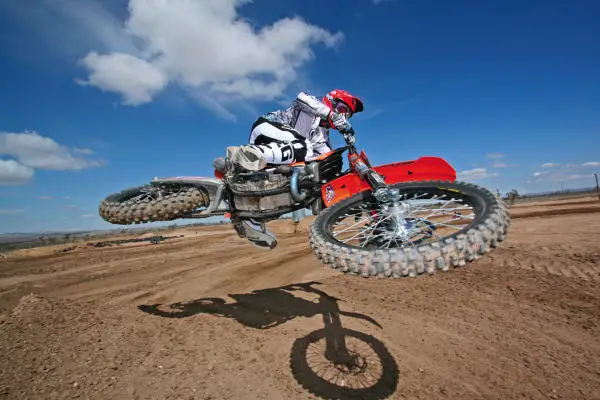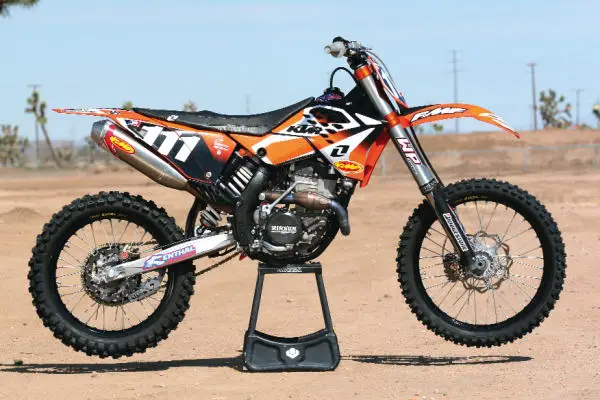WE RIDE MICHAEL SLEETER’S KTM SXS 250SXF:

At first, KTM didn’t want to divulge the secrets of the inner workings of their works engines, but we tricked them into telling us the whole story.
A fact that is little known is that KTM actually sells works bikes. Designated SXS’s, these bikes are decked-out versions that get the full benefit of all of the hard work of KTM’s test riders and factory racers. These are the bikes that the stars ride (on both the Grand Prix and National circuits). And they are available to Joe Public. The catch? They cost $10,438, and less than 15 are imported to the U.S. each year.
Mike Sleeter’s personal race bike is based on the SXS 250SXF, but, in truth, it is really a step beyond. The MXA wrecking crew has a lot of respect for the work that Mike Sleeter and the KTM guys put into developing their bikes (and we’re very interested in riding what they have been testing, especially since some of it will likely end up in production in the near future). To advance our goal of spying on the KTM development team, MXA called KTM to see if we could get our grubby little hands on Sleeter’s SXS KTM 250SXF. They said yes.

Mike Sleeter’s KTM SXS 250SXF isn’t built with refined factory racing components but it is built with initial prototypes and one-off custom parts.
AT FIRST, KTM DIDN’T WANT TO DIVULGE THE SECRETS OF THE INNER WORKINGS OF THEIR WORKS ENGINES, BUT WE TRICKED THEM INTO TELLING US THE WHOLE STORY. PLUS, KTM WANTS TO SELL THEIR SXS ENGINE KITS. THE SXS KITS HAVE PROVEN MORE POPULAR THAN THE COMPLETE SXS RACE BIKES.
There are three men at KTM’s head offices who hold the keys to Sleeter’s SXS 250 four-stroke. Layton Rice of KTM Factory Racing is in charge of building the engine. Ryan Ragland from KTM R&D is in charge of Sleeter’s suspension and chassis. And Scott Youngstrand, also from KTM R&D, is Sleeter’s mechanic.
At first, KTM didn’t want to divulge the secrets of the inner workings of their works engines, but we tricked them into telling us the whole story. Plus, KTM wants to sell their SXS engine kits. The SXS kits have proven more popular than the complete SXS race bikes. The engine kits include a high-performance crankshaft assembly, high-compression piston, race-tested camshaft, KTM Motorsport valve spring set, lighter counterbalancer, Hinson clutch, stronger gearbox, larger radiators, and special MSP CDI control unit Sleeter’s complete bike benefits from the all-around approach.

Sleeter’s 250cc engine ran like a miniature 450 until it reached the high rpm range, where it ran like an F1 car. KTM’s engine building reputation precedes them.
Second, in the chassis department, Sleeter’s bike had some very interesting modifications. The stock 20mm-offset triple clamps were replaced with 22mm-offset triple clamps. Sleeter, like many test riders before him, found that the chassis could be fine-tuned by altering the shape and width of the engine’s head stay. The result was improved feel through the whoops and better drive out of turns. Sleeter’s bike was also equipped with a custom chain guide, the purpose of which wasn’t durability, but better handling?achieved by modifying the effect of chain torque through the stroke of the PDS suspension. The chassis itself was slightly lengthened by moving the steering head bearing races forward in the steerer tube. This slight altering of the races changed the wheelbase, front center and weight bias.
Third, Sleeter’s SXS was stopped by Brembro brake calipers and stock-sized rotors (luckily the production KTMs come with the largest front rotor on the showroom floor). Sleeter’s suspension is a WP Factory Kit with 52mm fork legs, as opposed to the 48mm stockers. Bridgestone race tires are an important complement to the suspension and chassis.
Fourth, Sleeter uses a Twin Air filter, a Hinson clutch basket and cover, and stock gear ratios (transmitted through a gearbox built from high-quality gears). To lessen horsepower loss through drag or lubrication friction, Sleeter’s SXS KTM 250SXF utilizes Maxima lubricants. Oddly enough, some production KTM models come with Magura hydraulic clutches and others come with Brembos. KTM may be confused about which hydraulic clutch master cylinder is best, but Sleeter isn’t. He opts for the Magura over the Brembo (which comes standard on the 250SXF).

Despite the longer feel of the chassis, Sleeter’s bike was eager to carve into terra firma and lay waste to soft berms.
Fifth, other accoutrements include MDK titanium footpegs, Renthal 996 bars, 13/49 Renthal sprockets, a carbon fiber heat shield, an SXS carbon fiber gas petcock cover, SXS PHDS (Polyurethane Handlebar Dampening System) bar mounts, SXS billet aluminum gas cap, anti-slosh gas tank foam, SXS muffler guard, an SXS thumb-actuated hot-start lever, and a one-off version of a radiator overflow catch tank. Sleeter also runs an airbox cover with screened vent holes, but only for Supercross.
All of the trick parts on Sleeter’s bike were cool, but the titanium really made our mouths water. The subframe and almost all of the bolts on the bike were titanium, helping get the bike to its 214-pound weight.
TEST RIDE: WHEN IT SCREAMS, YOU SCREAM
When the MXA test crew first threw a leg over Sleeter’s KTM, we quickly discovered that Sleeter’s ergonomic setup was very comfortable. The overall feel wasn’t hindered by strange bar bends, low-rider pegs or oddball levers.
Oftentimes, a finely tuned, high-compression race bike is difficult to start. Sleeter’s SXS 250 engine turned over so easily that we could have started it by hand. At idle you could barely hear it ticking over. The AMA-legal FMF exhaust sounded more like a purring kitten than a growling tiger.
ON THE TRACK, THE SXS ENGINE KIT PRODUCED A HEALTHY DOSE OF TORQUEY POWER THROUGH THE LOW-END AND MIDRANGE. BEST OF ALL, THE KTM CONTINUED TO BUILD POWER WAY UP INTO THE RPM RANGE. AND WE MEAN WAY UP THERE.
On the track, the SXS engine kit produced a healthy dose of torquey power through the low-end and midrange. Best of all, the KTM continued to build power way up into the rpm range. And we mean way up there. If you think that high-rpm bikes have to sign off at some point, you are wrong! Sleeter’s SXS KTM 250SXF just kept on pulling. Every MXA test rider discovered that the power didn’t have a hard or violent hit anywhere on the curve. The KTM just builds power steadily and keeps right on building it to 14,000 rpm.
The amount of peak horsepower is impressive enough, but it is made all the more incredible by its breadth. MXA test riders started to make a game of finding Sleeter’s rev limiter. When we rode the bike to its fullest, shifted at peak, and rode hard, we couldn’t get there. Finally, one test rider decided to hold it wide open in third gear down the longest straight. Shrieking like a banshee and rocketing toward the final turn, he
eventually chickened out before the rev limiter kicked in.
Sleeter’s bike did feel a little longer than a regular KTM (because it is). Yet it was was eager to turn. The added length was offset by the reduction in trail (from the 22mm offset). Even though the forks were substantially stiffer than the shock, the bike didn’t ride like a chopper. It maintained good balance over the full range of obstacles. Sleeter’s bike still feels like a KTM, it just feels like a very refined KTM. It’s difficult to pinpoint any specific components that stand-out when everything just seems to meld together so well. It’s not always what a bike does, it’s also what a bike doesn’t do. Sleeter’s bike doesn’t deflect or bounce in strange directions at high speed over rough sections (the stocker often does). His bike was stable enough to be comfortable even when the ground was heaving and rolling. If we had to pick one aspect of Sleeter’s SXS KTM 250SXF to highlight, it would be the power of the front brake. We didn’t dare use more than one finger for fear of being catapulted over the handlebars.
Michael Sleeter and his SXS KTM 250SXF play more than a small part in improving the breed. If Sleeter’s bike is a window to the KTM’s of the future, then KTMs are going to be really good.





Comments are closed.